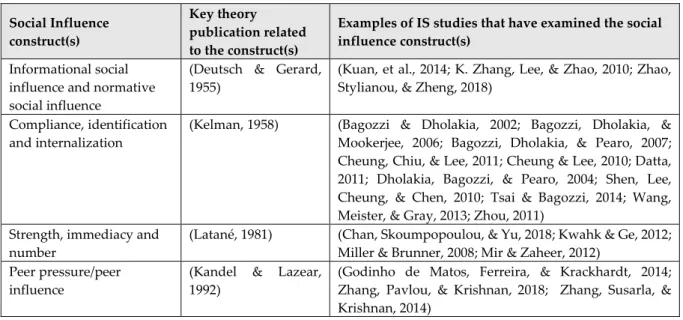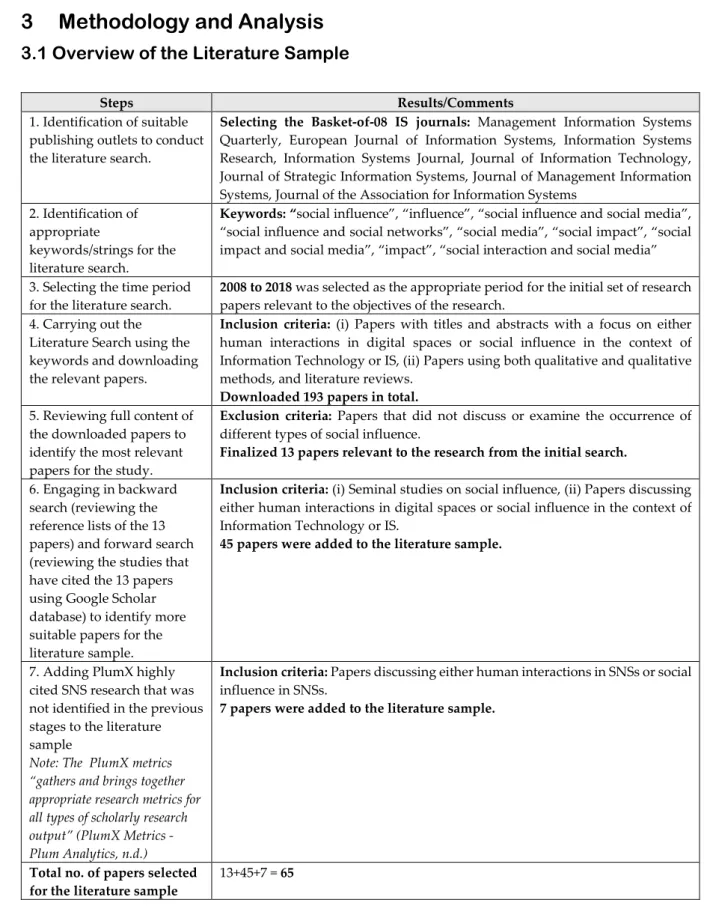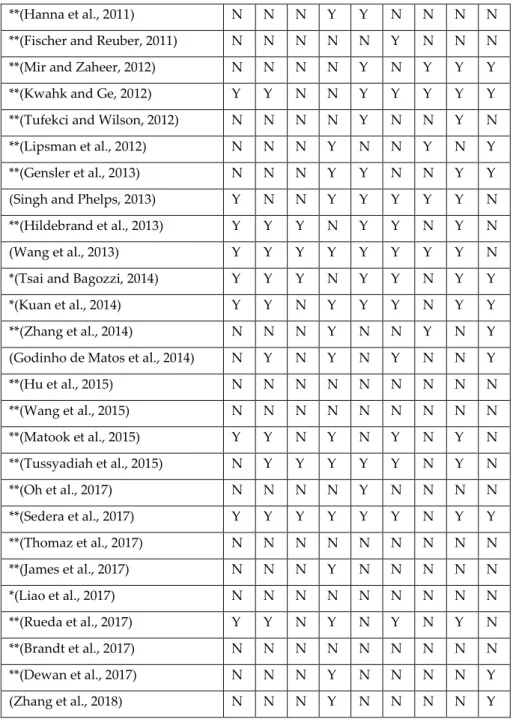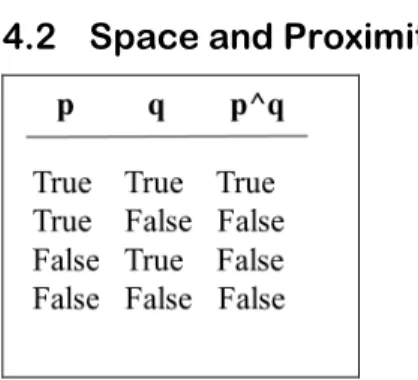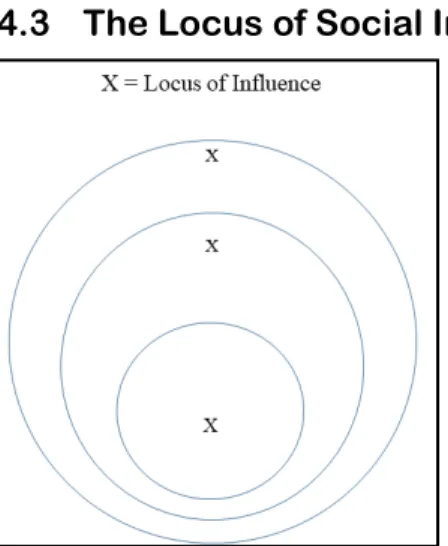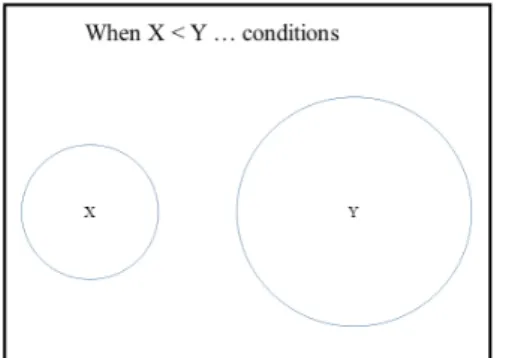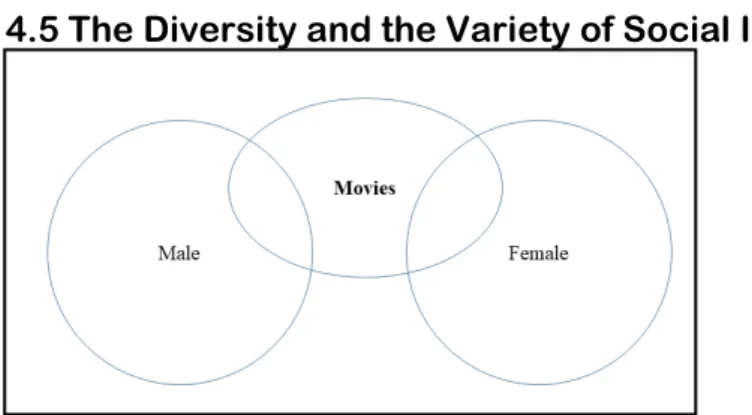IS scholars have used several constructs of social influence to investigate various phenomena in digital realms. Kelman's (1958) social influence theory and Latané's (1981) social influence theory have been widely used in IS to analyze individual actions and attitude changes in relation to social influence (see Table 2). We then narrowed down the most common constructs of social influence highlighted in the studies.
According to the analysis, the most discussed social influence constructs before 2008 were compliance (94%), normative social influence (94%) and strength (78%).

Overlaps between Constructs
The Evolution of Constructs
This finding is consistent with the argument from Zhou's (2011) study, which showed that constructs such as compliance cannot be applied to SNSs because individuals have the ability to make voluntary choices in SNSs. The lack of recognition of the new context may be one of the reasons why the same constructs of social influence (although there are slight differences in the order in which they are discussed) have emerged in IS studies. However, when considering the least discussed constructs, it was clear that peer influence (11%), one of the least discussed constructs in the pre-SNS era, was replaced by internalization (30%) in the SNS era.
The high number of members in an individual's social circle in the SNS era could be a reason why peer influence has been more discussed in the studies since 2008. Most interestingly, both immediacy and number of people remained among the least discussed constructs in both the pre- and pre-periods. -SNS and SNS eras. The complexity of considering a variety of social influence constructs in both the pre-SNS and SNS eras highlights the need to examine the boundary conditions for SNS by reviewing social influence theory and delineating the most appropriate constructs to investigate attitudinal and behavioral changes in individuals.
For example, if one considers the increase in interactions facilitated by the high number of people available on SNS (Smith, 2017), social influence constructs such as number of people and immediacy would become more important in the SNS era compared to pre -SNS era. However, such constructs still receive limited attention in SNS studies, as social influence constructs that were considered important in the pre-SNS era are being applied to the SNS era without acknowledging these contextual differences. Although some new constructs, such as popularity influence and proximity influence (Dewan et al., 2017) were introduced in IS studies to capture the social influence created by people on SNS, the emphasis placed on these constructs is still insufficient.
Context of the Study
Furthermore, while both virtual community and SNS studies have emphasized the importance of adopting selected constructs of social influence, such studies have rarely addressed the need to further refine the theoretical perspective of social influence in order to apply it successfully to the context of SNS. to apply This limitation encouraged us to look at boundary conditions that might allow IS researchers to better streamline social influence for SNSs. Therefore, the next step of the analysis was to derive boundary conditions based on the study sample.
We followed a logical approach to determine what boundary conditions would be appropriate for SNSs when examining social influence. First, referring to selected seminal works on boundary conditions and theory building, we identified how boundary conditions could be used to better apply a theory to a particular context and produce accurate results (Bacharach, 1989; Busse, Kach, & Wagner, 2017; Dubin, 1969; Weber, 2012; Whetten, 1989). We then carefully reviewed the articles in the literature sample through several iterations to examine the recurring concepts/themes in the literature sample that have been identified as useful when applying social influence to the context of SNSs.
For example, if some studies in the sample identified that the ability of SNS users to include or exclude people from their social circles (having a choice) should be considered when investigating social influence on SNS, we looked at all papers in the sample of study. , using that condition as a lens, to determine whether this condition can be applied to examine social influence in SNS-related research more effectively. The conditions thus identified were included as boundary conditions of social influence for SNSs. We continued this exercise, in identifying the conditions considered essential for the study of social influence on SNS in all 65 documents and extracted five boundary conditions.
4 Focus on Boundary Conditions
- The Choice of the Social Circle
- Space and Proximity
- The Locus of Social Influence
- The Number of People and Number of Times
- The Diversity and the Variety of Social Influence
Although various disciplines have studied the nature of social influence created on SNSs among individuals, much of the theoretical work supporting these discussions has been based on theories that were developed before the advent of SNSs. To better illustrate this, we have derived five salient boundary conditions through the analysis of our literature sample that influence the nature of social influence in the SNS era. Boundaries are important to the specification of any theoretical model.” The five derived boundary conditions; (i) choice, (ii) space and proximity, (iii) location of social influence, (iv) number of people and times, (v) diversity and variety of social influence, would thus add meaning to the study of social influence future in the context of SNSs.
Our analysis of the literature revealed that one of the least used constructs in the study sample was immediacy, indicating that researchers have underutilized constructs that could add more depth to our understanding of social influence in SNS. However, it is argued that not all fields have the same level of social influence. In addition, the locus of social influence would influence studies using (C) internalization as a facet of social influence.
Given the spheres of social networks, internalization can be short-term or long-term, depending on the locus of social influence. Moreover, the ice bucket challenge can be considered as another good example that shows the applicability of the social influence location boundary condition. Thus, constructs such as (E) informational social influence and (F) normative social influence will be influenced by the number of people and the number of times.
As illustrated in Table 4, the study by Kuan et al. 2014) have examined many constructs of social influence such as (A) compliance, (B) identification, (D) peer influence, (E) informational social influence, (F) normative social influence, (H) strength, and (I) number of people, implicitly to examine consumer actions. The researcher has an obligation to specify which spectrum of social influence is sought based on the variety and diversity of social influence a study population receives in SNSs.
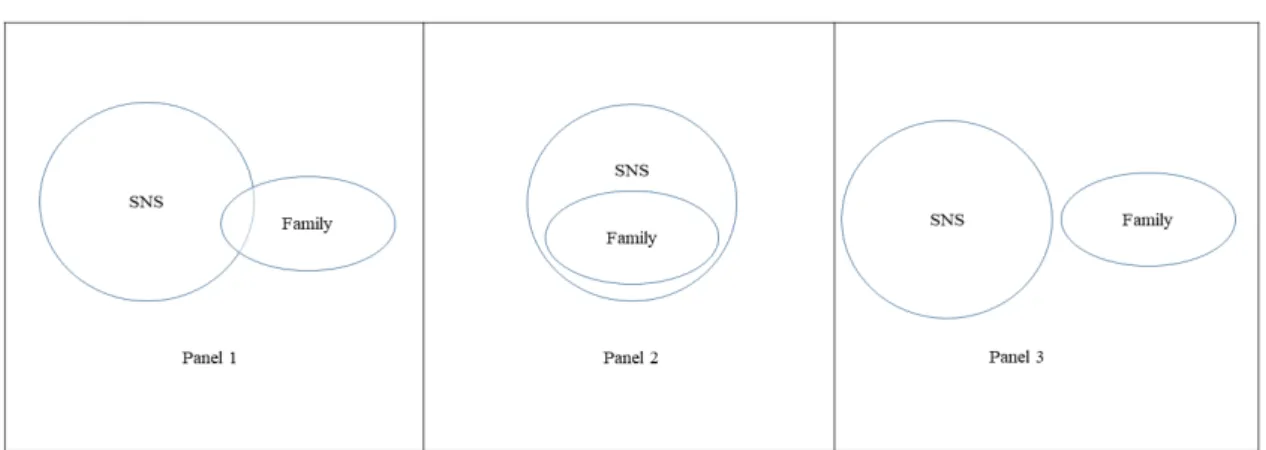
5 Conclusion
In particular, when exploring several constructs of social influence in the context of SNS, such as (A) conformity, (B) identification, (D) peer influence, (H) power, as shown in Table 4, the variety and diversity of social influence allows us to examine the role various influencers in SNS in encouraging individuals to change attitudes or behavior. Our analysis of 65 past studies shows that boundary conditions are useful for understanding social influence in the contemporary SNS environment. Although many IS studies have taken a social influence theoretical perspective in examining individual attitude and behavioral change, to date no study has explicitly acknowledged the necessity of developing boundary conditions for SNS research.
As such, the findings of this study can be used to further investigate social influence in SNSs. The derived boundary conditions will also allow future studies to be more specific when using social influence and make their findings more relevant to the context of SNSs. The five boundary conditions were determined based on literature, and the number of boundary conditions for SNS social influence studies may vary depending on further empirical testing.
Nevertheless, our aim at this point is to highlight the necessity of developing boundary conditions for SNS social influence studies, which we have. Our study encourages future research to incorporate these boundary conditions of social influence into studies of SNSs so that the theoretical constructs of social influence can be applied in a new way to relate to the context of SNSs. Furthermore, the derivation of boundary conditions for the theoretical perspective of social influence could be improved if a comparative analysis of social influence theories could be conducted across different disciplines.
Although our findings draw primarily on the IS literature, included research findings from other disciplines, including psychology, sociology, marketing, management studies, political science, and communication studies, it was not within the scope of our study to conduct an analysis comparative use of theoretical constructs of social influence for SNSs placing equal emphasis on published studies across disciplines. Social interaction through new social media: (How) interactions on Twitter can influence effective thinking and behavior. Informational and normative social influence on group buying: Evidence from self-reported data and EEG.
Liking - the key to my happiness: The moderating effect of social influence on travel experience. The Untold Story of Social Media on Offline Sales: The Impact of Facebook in the US Automotive Industry.
Appendix A – List of References for the Literature Synthesis Table (Table 4)
When social media can be bad for you: Community feedback stifles consumer creativity and reduces satisfaction with self-designed products. The role of social influence on the adoption of high-tech innovations: The moderating effect of public/private consumption. Proposing the online community self-disclosure model: The case of working professionals in France and the UK using online communities.
From traditional education technologies to student satisfaction in management education: A theory of the role of social media applications. How social influence affects our intention to use instant messaging: The moderating effect of usage experience. Gender differences in intentional social action: We aim to engage in team collaboration facilitated by social networks.
Networks, social influence, and the choice between competing innovations: insights from open source software licensing. The role of friends' appearance and behavior in evaluations of individuals on Facebook: Are we known to the company we manage.
